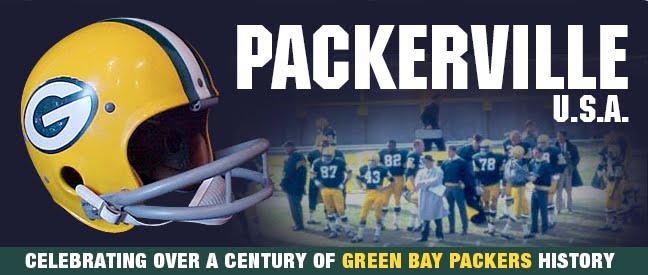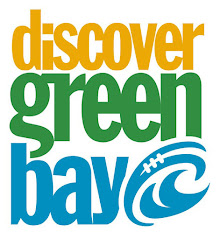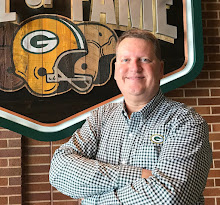
63 years ago yesterday, the Green Bay Packers won the 1944 NFL Championship, while World War II raged in Europe and the Pacific. Here is an account of the game:
THE LEAST-REMEMBERED CHAMPIONSHIP
By PFRA Research
Mostly it was the war. Patton was doing his end-run through Europe, the Marines were plunging across the Pacific, and long bombs were what the Air Force dropped on Berlin and Tokyo. Football — even a championship game — didn't seem all that important to most Americans. A diversion. No more.
Moreover, many of the stars who might have lifted the 1944 NFL Championship Game out of the commonplace were wearing khaki. That made it hard to gauge the Packers and Giants. How would they have fared against some of the pre-war powerhouses? Not too well, most people agreed.
Even the pairing was pedestrian. Baseball had been lucky. 1944 was the year the St. Louis Browns won a pennant, lending an aura of the unusual — even the bizarre — to the World Series. But the Packers and Giants? That was old news. The championship game ALWAYS had the Bears or Redskins or Packers or Giants. Was it an NFL rule?
Four decades later, it takes a good trivia expert to recall which teams played in 1944. If he can remember who won, he gets an orange wedge.
It's a shame really. The teams were actually pretty good, despite the loss of so many players to the military.
The Packers had Hutson, of course. Irv Comp, the passer, was no Cecil Isbell but he could get the job done. Ted Fritsch made a first-rate fullback and Lou Brock could scamper. The line had big Baby Ray, Buckets Goldenberg, Charley Brock, and Larry Craig. They ran off six straight wins to start the season and then coasted home at 8-2-0.
The Giants caught them relaxing four weeks before the end of the regular season and zapped them 24-0, then knocked off Washington twice in the final two games to nose out the Eagles and Redskins. A typical Steve Owen concoction, the New Yorkers played tough defense. During the season, they shutout half their opponents enroute to an 8-1-1 mark. Frank Cope, Al Blozis, Len Younce, and Mel Hein did the tough work in the line, and blond Bill Paschal was the league's best runner. In a "human interest" story, long-time Packer thrower Arnie Herber came out of retirement, paunchy and graying, to give New York its best passing in years.
A large and loyal New York crowd of 46,016 showed up at the Polo Grounds on December 17. They hoped Paschal could still go despite an ankle injured in the final regular season game against the Redskins. They prayed Hutson could be held to some ordinary mortal stats by tough Giant double and triple-teaming. They wanted a win.
In the push-and-shove first quarter neither team gained an advantage. New York defenders covered Hutson like a coat of whitewash. That was the good news for Giant fans. The bad news was that Paschal's ankle made him nearly immobile. About all he could do in the backfield was act as a decoy.
Early in the second quarter, Green Bay gained decent field position with a punt return to the New York 48. On first down, eleven-year veteran Joe Laws slashed through the line for 20 yards. Before the Giants got their bearings, 210-pound Ted Fritsch rumbled for 27 more to put the ball at the one. New York's tough defense stiffened and held off the Packers for three downs, but on the fourth Fritsch smashed over behind Goldenberg's block for a touchdown. Hutson kicked the PAT and Green Bay led 7-0.
New York still couldn't get any offense going. Late in the second period the Packers started another drive at their own 38. On third and three, Hutson worked clear of the Giant defenders and Comp hit him for a 24-yard gain to the New York 30. Three downs gained only two yards and only a little over a minute remained in the half. Everyone in the Polo Grounds knew it was "Hutson time."
At the snap Hutson moved to the right and virtually every Giant on the field (and probably some on the bench) moved with him like a herd of lemmings. Meanwhile, Ted Fritsch strolled through the line, looking for all the world like a guy out on his Sunday constitutional. None of the New Yorkers paid him a mind. He would have had to have insulted their mothers to get a glance. Everyone was after Hutson.
But once he was past the line of scrimmage, Ted put on speed and for a big guy he could motor pretty well. When Comp finally launched his pass, it wasn't to Hutson loping through a Giant team meeting to the right. Instead it went straight down the middle to Fritsch, the lonely guy at the five. Once Ted clutched the ball he could have sung two choruses of the Packer fight song and still walked over the goal line before any Giant could have caught up with him. Hutson kicked the extra point to put the score at 14-0, but he deserved credit for the touchdown too.
Down by two TDs as the second half began, the Giants had to pass and Green Bay knew it. Old friend Arnie Herber was playing against a stacked deck and a couple of his tosses were picked off — Joe Laws had three interceptions on the day — but he kept pitching. With Paschal unable to run, there wasn't much else in the New York arsenel.
Late in the third stanza, Arnie hoisted a long one to Frank Liebel for 41 yards to take ball to the Packer one. Another ex-Wisconsinite, Marquette's Ward Cuff, smacked over for the score on the first play of the final quarter. Ward had spent eight years as a New York wingback, but he took this one in from tailback — one of those little adjustments necessitated by Paschal's injury. Ken Strong, who'd been kicking since Walter Camp was around, knocked the football through the uprights to make the score 14-7.
Giant fans screamed for just one more big pass from Herber's ancient arm. Arnie did his best to accommodate them. A final desperation drive late in the period was going pretty well. But suddenly Green Bay's Paul Duhart was in the right spot at the right time — the Packer 20 just as a Herber heave descended on that spot. It was Green Bay's fourth interception and New York's last gasp.
All things considered, it wasn't a bad game. It broke all play-off game records financially with a gross gate of $146,205.15 and a net gate after taxes of $121,703. Each Packer got $1,449.71; each Giant $814.36. There was lots of great defense and a couple of big plays. It almost had a great comeback, and it did have some human interest in Arnie Herber versus his old team. It was Al Blozis' last game. It even had one of those screwy twists people like to remember — the biggest offensive threats for both teams, Hutson and Paschal, were used almost exclusively as decoys.
But you never hear fans fondly reminiscing about the "Decoy Game." Instead it's "Who played?" "Who won?" "Who cares?" Fans forget a lot of games, of course, even championships, but — if such a thing could be measured — this one would win the cup as least remembered. And they'd probably forget to inscribe it.
Mostly it was the war.
Sunday, December 17, 1944, at New York
Polo Grounds - Attendance 46,016
GREEN BAY PACKERS:
Don Hutson (LE)
Baby Ray (LT)
Bill Kuusisto (LG)
Charley Brock (C)
Buckets Goldenberg (RG)
Paul Berezney (RT)
Harry Jacunski (RE)
Larry Craig (QB)
Irv Comp (LH)
Joe Laws (RH)
Ted Fritsch (FB)
NEW YORK GIANTS:
Neal Adams (LE)
Frank Cope (LT)
Len Younce (LG)
Mel Hein (C)
Jim Sivell (RG)
Vic Carroll (RT)
Frank Liebel (RE)
Len Calligaro (QB)
Arnie Herber (LH)
Ward Cuff (RH)
Howie Livingston (FB)
Substitutes: E- Ray Wehba; T- Tiny Croft; E- John Weiss, Verlin Adams; G- Pete Tinsley, Glen Soren; T- Al Blozis; G-Chuck Avedison; B- Lou Brock, Don sian; B- Bill Petrilis, Bill Perkins, Paul Duhart. Paschal, Carl Kinscherf, Joe Sulaitis, Hub Barker, Ken Strong.
Green Bay Packers 0 14 0 0 - 14
New York Giants 0 0 0 7 - 7
2nd Quarter
GB - Fritsch1 run. (Hutson PK) 2:26
GB - Fritsch 28 pass from Comp. (Hutson PK) 13:43
4th Quarter
NY - Cuff 1 run. (Strong PK) 0:03
Statistics
Rushing GB- 47-184-3.9: Laws 13-72-5.5; Fritsch 18-59-3.3; Comp 7-42-6.0; Duhart 7-15-2.1; Perkins 2-(-)4-(-)2.0.
Rushing NY- 27-101-3.7: Cuff 12-76-6.3; Livingston 12-22- 1.8; Paschal 2-4-2.0; Sulaitis 1-(-)1-(-)1.0.
Receiving GB- Hutson 2-46-23.0; Fritsch 1-28-28.0.
Receiving NY- Liebel 3-70-23.3; Cuff 2-23-11.5; Livingston 2-21-10.5; Barker 1-0-0.0.
Passing GB- 11-3-74-3: Comp 10-3-74-3; L.Brock 1-0-0-0.
Passing NY (Herber)- 22-8-114-4.
Punting GB- 10-38.5: L.Brock 6-36.8; Fritsch 4-41.0.
Punting NY (Younce)- 10-41.0















































































